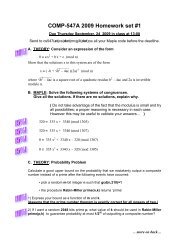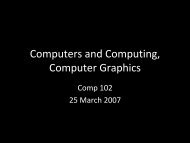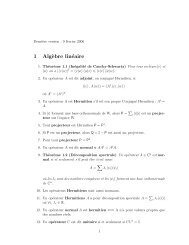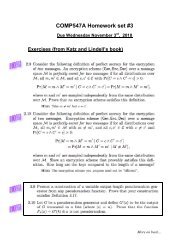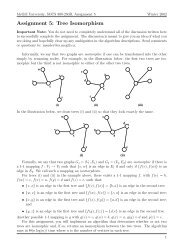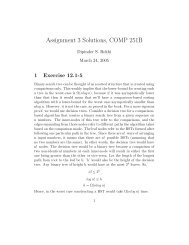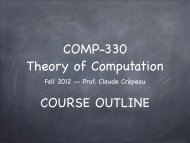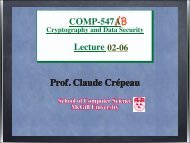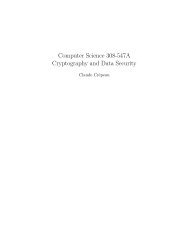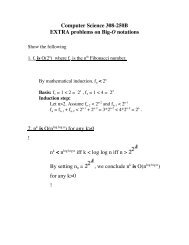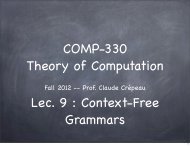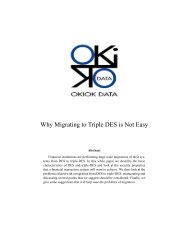COMP 547: Assignment 1 Solutions
COMP 547: Assignment 1 Solutions
COMP 547: Assignment 1 Solutions
You also want an ePaper? Increase the reach of your titles
YUMPU automatically turns print PDFs into web optimized ePapers that Google loves.
Type x yx zx zyx<br />
Amount 24 23 27 26<br />
Table 1: Summary of results for problem 11.<br />
5)<br />
<strong>547</strong>1234567988 is not in QR_n (root of yx: 125637127136393030\<br />
900524755578585052721630258447382451765030144949951207786646\<br />
110838585885971204218719872431155751276782292634789749171217\<br />
050399637909286063835079790158907905880286681588957215994637\<br />
4)<br />
<strong>547</strong>1234567989 is not in QR_n (root of yx: 130096871661902070\<br />
710031752707137582830741110348039577107913444950334782429346\<br />
834499138925114821873522260732875624204023958322262242726896\<br />
915774023449924304056024312035505160809645729<strong>547</strong>061229283948\<br />
0)<br />
24, 23, 27, 26<br />
These results are summarised in table 1.<br />
12. We will first propose a way to check that n, y and z have all been chosen<br />
correctly and then discuss how and why it works. Let X be a set of 100<br />
random number in Z ∗ n.<br />
Here is a way to check that n, y and z have all been chosen correctly:<br />
(a) Compute ( y<br />
n)<br />
. If it is not 1, return fail.<br />
(b) Compute ( z<br />
n)<br />
. If it is not −1, return fail.<br />
(c) Sum up the amounts of variants of x ∈ X that are in QR n (that is,<br />
the numbers of x’s, yx’s, zx’s and zyx’s in QR n ). If they do not sum<br />
up to 100, return fail.<br />
(d) If they do sum up to 100, they should be more or less evenly distributed<br />
in the four categories. At this point, it is safe to return<br />
succeed.<br />
Let us assume, for the moment, that n, y and z have all been chosen correctly.<br />
We will make some important observations concerning our results<br />
in this case of correctly chosen parameters.<br />
We know that given a prime r, exactly half of the integers between 1 and<br />
r − 1 are in QR r . Thus, using some intuition, if n = pq, we would expect<br />
about half of the integers in X to be in QR p and about half of them to be<br />
in QR q . Of course, it will generally not be the case that exactly half of the<br />
26



